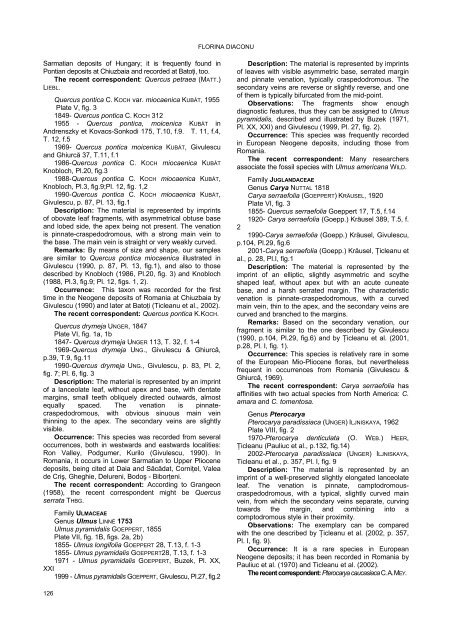Create successful ePaper yourself
Turn your PDF publications into a flip-book with our unique Google optimized e-Paper software.
FLORINA DIACONU<br />
Sarmatian deposits of Hungary; it is frequently found in<br />
Pontian deposits at Chiuzbaia and recorded at Batoţi, too.<br />
The recent correspondent: Quercus petraea (MATT.)<br />
LIEBL.<br />
Quercus pontica C. KOCH var. miocaenica KUBÁT, 1955<br />
Plate V, fig. 3<br />
1849- Quercus pontica C. KOCH 312<br />
1955 - Quercus pontica, moicenica KUBÁT in<br />
Andrenszky et Kovacs-Sonkodi 175, T.10, f.9. T. 11, f.4,<br />
T. 12, f.5<br />
1969- Quercus pontica moicenica KUBÁT, Givulescu<br />
and Ghiurcă 37, T.11, f.1<br />
1986-Quercus pontica C. KOCH miocaenica KUBÁT<br />
Knobloch, Pl.20, fig.3<br />
1988-Quercus pontica C. KOCH miocaenica KUBÁT,<br />
Knobloch, Pl.3, fig.9;Pl. 12, fig. 1,2<br />
1990-Quercus pontica C. KOCH miocaenica KUBÁT,<br />
Givulescu, p. 87, Pl. 13, fig.1<br />
Description: The material is represented by imprints<br />
of obovate leaf fragments, with asymmetrical obtuse base<br />
and lobed side, the apex being not present. The venation<br />
is pinnate-craspedodromous, with a strong main vein to<br />
the base. The main vein is straight or very weakly curved.<br />
Remarks: By means of size and shape, our samples<br />
are similar to Quercus pontica miocaenica illustrated in<br />
Givulescu (1990, p. 87, Pl. 13, fig.1), and also to those<br />
described by Knobloch (1986, Pl.20, fig. 3) and Knobloch<br />
(1988, Pl.3, fig.9; Pl. 12, figs. 1, 2).<br />
Occurrence: This taxon was recorded for the first<br />
time in the Neogene deposits of Romania at Chiuzbaia by<br />
Givulescu (1990) and later at Batoţi (Ticleanu et al., 2002).<br />
The recent correspondent: Quercus pontica K.KOCH.<br />
Quercus drymeja UNGER, 1847<br />
Plate VI, fig. 1a, 1b<br />
1847- Quercus drymeja UNGER 113, T. 32, f. 1-4<br />
1969-Quercus drymeja UNG., Givulescu & Ghiurcă,<br />
p.39, T.9, fig.11<br />
1990-Quercus drymeja UNG., Givulescu, p. 83, Pl. 2,<br />
fig. 7; Pl. 6, fig. 3<br />
Description: The material is represented by an imprint<br />
of a lanceolate leaf, without apex and base, with dentate<br />
margins, small teeth obliquely directed outwards, almost<br />
equally spaced. The venation is pinnatecraspedodromous,<br />
with obvious sinuous main vein<br />
thinning to the apex. The secondary veins are slightly<br />
visible.<br />
Occurrence: This species was recorded from several<br />
occurrences, both in westwards and eastwards localities:<br />
Ron Valley, Podgumer, Kurilo (Givulescu, 1990). In<br />
Romania, it occurs in Lower Sarmatian to Upper Pliocene<br />
deposits, being cited at Daia and Săcădat, Corniţel, <strong>Valea</strong><br />
de Criş, Gheghie, Delureni, Bodoş - Biborţeni.<br />
The recent correspondent: According to Grangeon<br />
(1958), the recent correspondent might be Quercus<br />
serrata THBG.<br />
Family ULMACEAE<br />
Genus Ulmus LINNÉ 1753<br />
Ulmus pyramidalis GOEPPERT, 1855<br />
Plate V<strong>II</strong>, fig. 1B, figs. 2a, 2b)<br />
1855- Ulmus longifolia GOEPPERT 28, T.13, f. 1-3<br />
1855- Ulmus pyramidalis GOEPPERT28, T.13, f. 1-3<br />
1971 - Ulmus pyramidalis GOEPPERT, Buzek, Pl. XX,<br />
XXI<br />
1999 - Ulmus pyramidalis GOEPPERT, Givulescu, Pl.27, fig.2<br />
Description: The material is represented by imprints<br />
of leaves with visible asymmetric base, serrated margin<br />
and pinnate venation, typically craspedodromous. The<br />
secondary veins are reverse or slightly reverse, and one<br />
of them is typically bifurcated from the mid-point.<br />
Observations: The fragments show enough<br />
diagnostic features, thus they can be assigned to Ulmus<br />
pyramidalis, described and illustrated by Buzek (1971,<br />
Pl. XX, XXI) and Givulescu (1999, Pl. 27, fig. 2).<br />
Occurrence: This species was frequently recorded<br />
in European Neogene deposits, including those from<br />
Romania.<br />
The recent correspondent: Many researchers<br />
associate the fossil species with Ulmus americana WILD.<br />
Family JUGLANDACEAE<br />
Genus Carya NUTTAL 1818<br />
Carya serraefolia (GOEPPERT) KRÄUSEL, 1920<br />
Plate VI, fig. 3<br />
1855- Quercus serraefolia Goeppert 17, T.5, f.14<br />
1920- Carya serraefolia (Goepp.) Kräusel 389, T.5, f.<br />
2<br />
1990-Carya serraefolia (Goepp.) Kräusel, Givulescu,<br />
p.104, Pl.29, fig.6<br />
2001-Carya serraefolia (Goepp.) Kräusel, Ţicleanu et<br />
al., p. 28, Pl.I, fig.1<br />
Description: The material is represented by the<br />
imprint of an elliptic, slightly asymmetric and scythe<br />
shaped leaf, without apex but with an acute cuneate<br />
base, and a harsh serrated margin. The characteristic<br />
venation is pinnate-craspedodromous, with a curved<br />
main vein, thin to the apex, and the secondary veins are<br />
curved and branched to the margins.<br />
Remarks: Based on the secondary venation, our<br />
fragment is similar to the one described by Givulescu<br />
(1990, p.104, Pl.29, fig.6) and by Ţicleanu et al. (2001,<br />
p.28, Pl. I, fig. 1).<br />
Occurrence: This species is relatively rare in some<br />
of the European Mio-Pliocene floras, but nevertheless<br />
frequent in occurrences from Romania (Givulescu &<br />
Ghiurcă, 1969).<br />
The recent correspondent: Carya serraefolia has<br />
affinities with two actual species from North America: C.<br />
amara and C. tomentosa.<br />
Genus Pterocarya<br />
Pterocarya paradissiaca (UNGER) ILJNISKAYA, 1962<br />
Plate V<strong>II</strong>I, fig. 2<br />
1970-Pterocarya denticulata (O. WEB.) HEER,<br />
Ţicleanu (Pauliuc et al., p.132, fig.14)<br />
2002-Pterocarya paradissiaca (UNGER) ILJNISKAYA,<br />
Ticleanu et al., p. 357, Pl. I, fig. 9<br />
Description: The material is represented by an<br />
imprint of a well-preserved slightly elongated lanceolate<br />
leaf. The venation is pinnate, camptodromouscraspedodromous,<br />
with a typical, slightly curved main<br />
vein, from which the secondary veins separate, curving<br />
towards the margin, and combining into a<br />
comptodromous style in their proximity.<br />
Observations: The exemplary can be compared<br />
with the one described by Ţicleanu et al. (2002, p. 357,<br />
Pl. I, fig. 9).<br />
Occurrence: It is a rare species in European<br />
Neogene deposits; it has been recorded in Romania by<br />
Pauliuc et al. (1970) and Ticleanu et al. (2002).<br />
The recent correspondent: Pterocarya caucasiaca C. A. MEY.<br />
126

















